A Compilation Of Stuff I Know About Drawing Asian Faces And Asian Culture! I Feel Like Many “How-To-Draw”
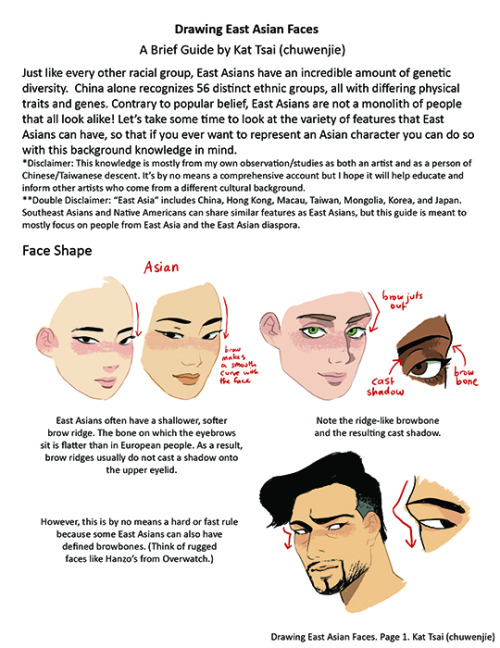
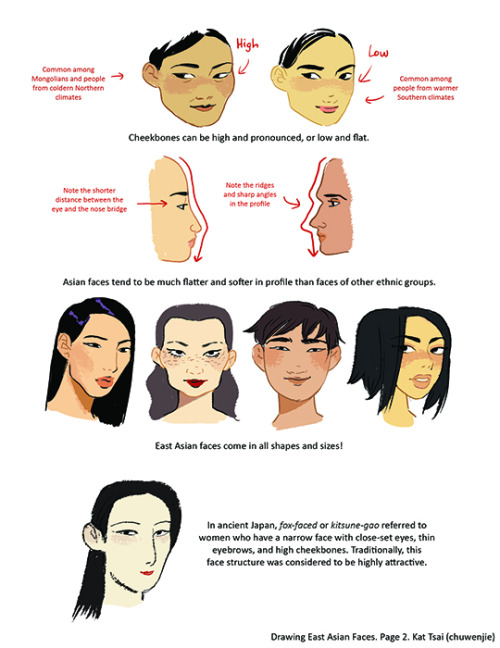

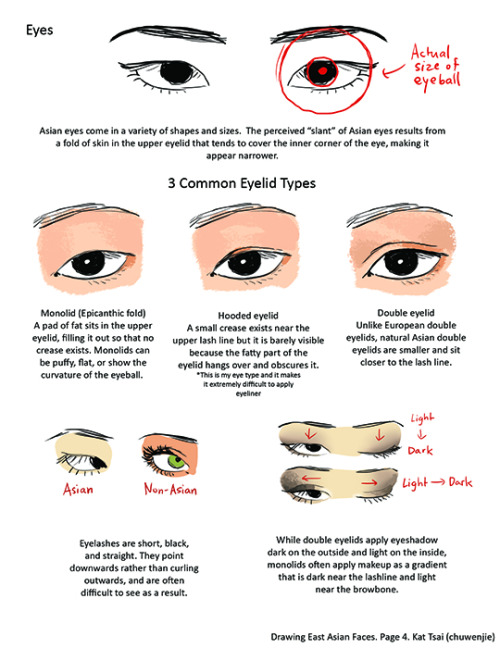

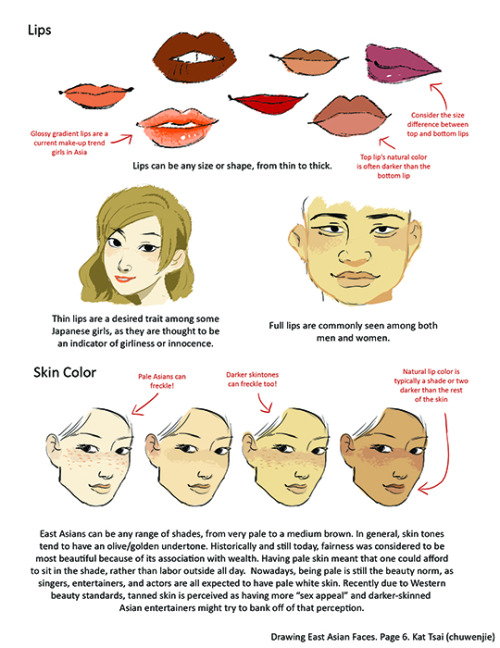
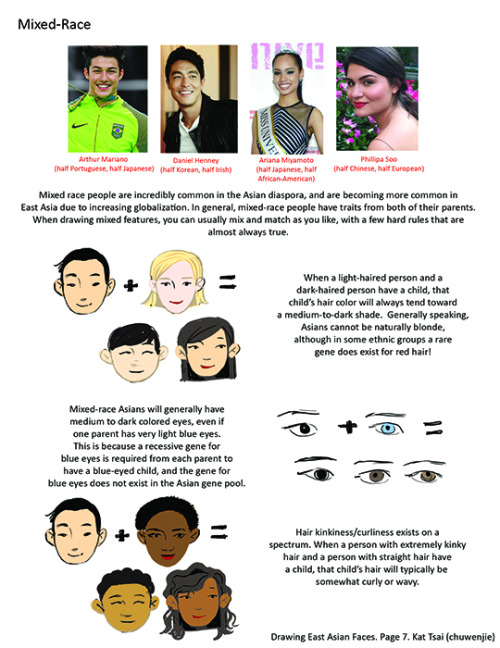
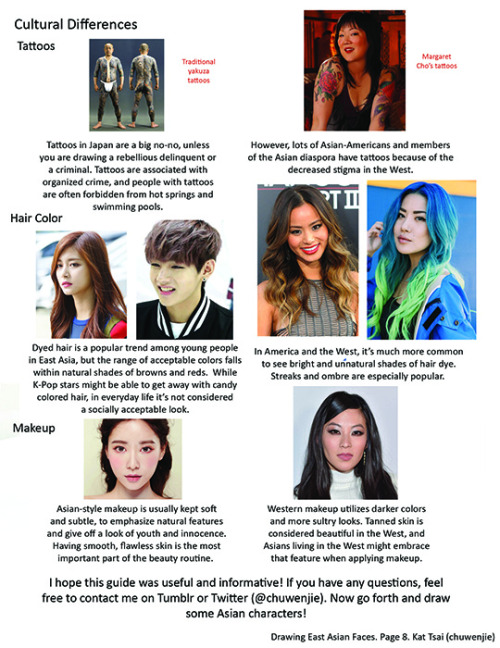
A compilation of stuff I know about drawing Asian faces and Asian culture! I feel like many “How-To-Draw” tutorials often default to European faces and are not really helpful when drawing people of other races. So I thought I’d put this together in case anyone is interested! Feel free to share this guide and shoot me questions if you have any! I’m by no means an expert, I just know a few things from drawing experience and from my own cultural background.
More Posts from Violetdawn001 and Others
This exactly fits Lurien, but hear me out. Give him an umbrella that turns into an umbrella-rifle or umbrella-sword and that would be Perfection!

Lurien concept
Coming back to Black and White to realize "Oh hey, not everything IS black and white. Life's complicated!"
And then they immediately throw Ghetsis in your face. The guy whose mask of lies paint him as Pure White but to call Ghetsis' heart Black would be an insult to the color as his heart is darker than that.
Anyways, I like the fact that Game Freak still took the time to show that truly evil people do exist and they hate us, wanting nothing but us underneath their control (or if that fails) or dead. 💀 Because I ran into rl people like Ghetsis' and I am so happy I was prepared to meet them by playing Pokemon Black and White.
Revisiting Black and White as an adult and a Disability Studies student is wild
Wow Ghetsis is a lot more problematic than I remembered
Excuse me while I reblog this for future reference...
Words for Skin Tone | How to Describe Skin Color
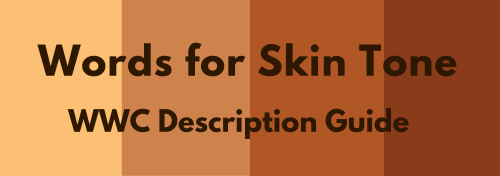
We discussed the issues describing People of Color by means of food in Part I of this guide, which brought rise to even more questions, mostly along the lines of “So, if food’s not an option, what can I use?” Well, I was just getting to that!
This final portion focuses on describing skin tone, with photo and passage examples provided throughout. I hope to cover everything from the use of straight-forward description to the more creatively-inclined, keeping in mind the questions we’ve received on this topic.
Standard Description
Basic Colors

Pictured above: Black, Brown, Beige, White, Pink.
“She had brown skin.”
This is a perfectly fine description that, while not providing the most detail, works well and will never become cliché.
Describing characters’ skin as simply brown or beige works on its own, though it’s not particularly telling just from the range in brown alone.
Complex Colors
These are more rarely used words that actually “mean” their color. Some of these have multiple meanings, so you’ll want to look into those to determine what other associations a word might have.

Pictured above: Umber, Sepia, Ochre, Russet, Terra-cotta, Gold, Tawny, Taupe, Khaki, Fawn.
Complex colors work well alone, though often pair well with a basic color in regards to narrowing down shade/tone.
For example: Golden brown, russet brown, tawny beige…
As some of these are on the “rare” side, sliding in a definition of the word within the sentence itself may help readers who are unfamiliar with the term visualize the color without seeking a dictionary.
“He was tall and slim, his skin a russet, reddish-brown.”
Comparisons to familiar colors or visuals are also helpful:
“His skin was an ochre color, much like the mellow-brown light that bathed the forest.”
Modifiers
Modifiers, often adjectives, make partial changes to a word.The following words are descriptors in reference to skin tone.
Dark - Deep - Rich - Cool
Warm - Medium - Tan
Fair - Light - Pale
Rich Black, Dark brown, Warm beige, Pale pink…
If you’re looking to get more specific than “brown,” modifiers narrow down shade further.
Keep in mind that these modifiers are not exactly colors.
As an already brown-skinned person, I get tan from a lot of sun and resultingly become a darker, deeper brown. I turn a pale, more yellow-brown in the winter.
While best used in combination with a color, I suppose words like “tan” “fair” and “light” do work alone; just note that tan is less likely to be taken for “naturally tan” and much more likely a tanned White person.
Calling someone “dark” as description on its own is offensive to some and also ambiguous. (See: Describing Skin as Dark)
Undertones
Undertones are the colors beneath the skin, seeing as skin isn’t just one even color but has more subdued tones within the dominating palette.
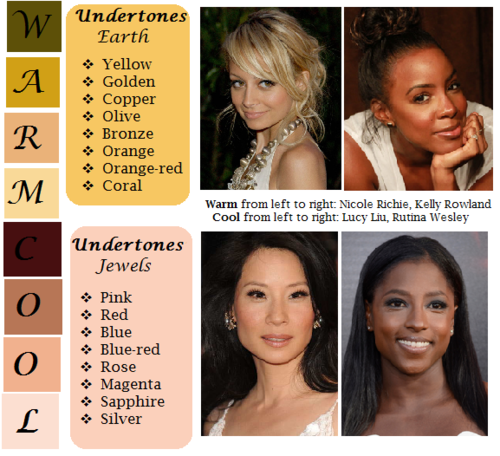
pictured above: warm / earth undertones: yellow, golden, copper, olive, bronze, orange, orange-red, coral | cool / jewel undertones: pink, red, blue, blue-red, rose, magenta, sapphire, silver.
Mentioning the undertones within a character’s skin is an even more precise way to denote skin tone.
As shown, there’s a difference between say, brown skin with warm orange-red undertones (Kelly Rowland) and brown skin with cool, jewel undertones (Rutina Wesley).
“A dazzling smile revealed the bronze glow at her cheeks.”
“He always looked as if he’d ran a mile, a constant tinge of pink under his tawny skin.”
Standard Description Passage
“Farah’s skin, always fawn, had burned and freckled under the summer’s sun. Even at the cusp of autumn, an uneven tan clung to her skin like burrs. So unlike the smooth, red-brown ochre of her mother, which the sun had richened to a blessing.”
-From my story “Where Summer Ends” featured in Strange Little Girls
Here the state of skin also gives insight on character.
Note my use of “fawn” in regards to multiple meaning and association. While fawn is a color, it’s also a small, timid deer, which describes this very traumatized character of mine perfectly.
Though I use standard descriptions of skin tone more in my writing, at the same time I’m no stranger to creative descriptions, and do enjoy the occasional artsy detail of a character.
Creative Description
Whether compared to night-cast rivers or day’s first light…I actually enjoy seeing Characters of Colors dressed in artful detail.
I’ve read loads of descriptions in my day of white characters and their “smooth rose-tinged ivory skin”, while the PoC, if there, are reduced to something from a candy bowl or a Starbucks drink, so to actually read of PoC described in lavish detail can be somewhat of a treat.
Still, be mindful when you get creative with your character descriptions. Too many frills can become purple-prose-like, so do what feels right for your writing when and where. Not every character or scene warrants a creative description, either. Especially if they’re not even a secondary character.
Using a combination of color descriptions from standard to creative is probably a better method than straight creative. But again, do what’s good for your tale.
Natural Settings - Sky

Pictured above: Harvest Moon -Twilight, Fall/Autumn Leaves, Clay, Desert/Sahara, Sunlight - Sunrise - Sunset - Afterglow - Dawn- Day- Daybreak, Field - Prairie - Wheat, Mountain/Cliff, Beach/Sand/Straw/Hay.
Now before you run off to compare your heroine’s skin to the harvest moon or a cliff side, think about the associations to your words.
When I think cliff, I think of jagged, perilous, rough. I hear sand and picture grainy, yet smooth. Calm. mellow.
So consider your character and what you see fit to compare them to.
Also consider whose perspective you’re describing them from. Someone describing a person they revere or admire may have a more pleasant, loftier description than someone who can’t stand the person.
“Her face was like the fire-gold glow of dawn, lifting my gaze, drawing me in.”
“She had a sandy complexion, smooth and tawny.”
Even creative descriptions tend to draw help from your standard words.
Flowers
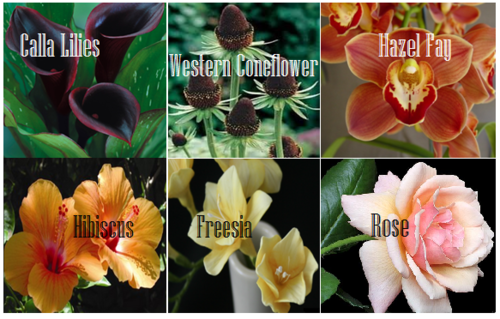
Pictured above: Calla lilies, Western Coneflower, Hazel Fay, Hibiscus, Freesia, Rose
It was a bit difficult to find flowers to my liking that didn’t have a 20 character name or wasn’t called something like “chocolate silk” so these are the finalists.
You’ll definitely want to avoid purple-prose here.
Also be aware of flowers that most might’ve never heard of. Roses are easy, as most know the look and coloring(s) of this plant. But Western coneflowers? Calla lilies? Maybe not so much.
“He entered the cottage in a huff, cheeks a blushing brown like the flowers Nana planted right under my window. Hazel Fay she called them, was it?”
Assorted Plants & Nature

Pictured above: Cattails, Seashell, Driftwood, Pinecone, Acorn, Amber
These ones are kinda odd. Perhaps because I’ve never seen these in comparison to skin tone, With the exception of amber.
At least they’re common enough that most may have an idea what you’re talking about at the mention of “pinecone.“
I suggest reading out your sentences aloud to get a better feel of how it’ll sounds.
"Auburn hair swept past pointed ears, set around a face like an acorn both in shape and shade.”
I pictured some tree-dwelling being or person from a fantasy world in this example, which makes the comparison more appropriate.
I don’t suggest using a comparison just “cuz you can” but actually being thoughtful about what you’re comparing your character to and how it applies to your character and/or setting.
Wood

Pictured above: Mahogany, Walnut, Chestnut, Golden Oak, Ash
Wood can be an iffy description for skin tone. Not only due to several of them having “foody” terminology within their names, but again, associations.
Some people would prefer not to compare/be compared to wood at all, so get opinions, try it aloud, and make sure it’s appropriate to the character if you do use it.
“The old warlock’s skin was a deep shade of mahogany, his stare serious and firm as it held mine.”
Metals

Pictured above: Platinum, Copper, Brass, Gold, Bronze
Copper skin, brass-colored skin, golden skin…
I’ve even heard variations of these used before by comparison to an object of the same properties/coloring, such as penny for copper.
These also work well with modifiers.
“The dress of fine white silks popped against the deep bronze of her skin.”
Gemstones - Minerals
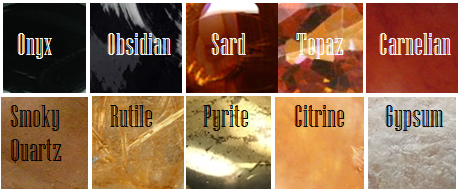
Pictured above: Onyx, Obsidian, Sard, Topaz, Carnelian, Smoky Quartz, Rutile, Pyrite, Citrine, Gypsum
These are trickier to use. As with some complex colors, the writer will have to get us to understand what most of these look like.
If you use these, or any more rare description, consider if it actually “fits” the book or scene.
Even if you’re able to get us to picture what “rutile” looks like, why are you using this description as opposed to something else? Have that answer for yourself.
“His skin reminded her of the topaz ring her father wore at his finger, a gleaming stone of brown, mellow facades.”
Physical Description
Physical character description can be more than skin tone.
Show us hair, eyes, noses, mouth, hands…body posture, body shape, skin texture… though not necessarily all of those nor at once.
Describing features also helps indicate race, especially if your character has some traits common within the race they are, such as afro hair to a Black character.
How comprehensive you decide to get is up to you. I wouldn’t overdo it and get specific to every mole and birthmark. Noting defining characteristics is good, though, like slightly spaced front teeth, curls that stay flopping in their face, hands freckled with sunspots…
General Tips
Indicate Race Early: I suggest indicators of race be made at the earliest convenience within the writing, with more hints threaded throughout here and there.
Get Creative On Your Own: Obviously, I couldn’t cover every proper color or comparison in which has been “approved” to use for your characters’ skin color, so it’s up to you to use discretion when seeking other ways and shades to describe skin tone.
Skin Color May Not Be Enough: Describing skin tone isn’t always enough to indicate someone’s ethnicity. As timeless cases with readers equating brown to “dark white” or something, more indicators of race may be needed.
Describe White characters and PoC Alike: You should describe the race and/or skin tone of your white characters just as you do your Characters of Color. If you don’t, you risk implying that White is the default human being and PoC are the “Other”).
PSA: Don’t use “Colored.” Based on some asks we’ve received using this word, I’d like to say that unless you or your character is a racist grandmama from the 1960s, do not call People of Color “colored” please.
Not Sure Where to Start? You really can’t go wrong using basic colors for your skin descriptions. It’s actually what many people prefer and works best for most writing. Personally, I tend to describe my characters using a combo of basic colors + modifiers, with mentions of undertones at times. I do like to veer into more creative descriptions on occasion.
Want some alternatives to “skin” or “skin color”? Try: Appearance, blend, blush, cast, coloring, complexion, flush, glow, hue, overtone, palette, pigmentation, rinse, shade, sheen, spectrum, tinge, tint, tone, undertone, value, wash.
Skin Tone Resources
List of Color Names
The Color Thesaurus
Skin Undertone & Color Matching
Tips and Words on Describing Skin
Photos: Undertones Described (Modifiers included)
Online Thesaurus (try colors, such as “red” & “brown”)
Don’t Call me Pastries: Creative Skin Tones w/ pics I
Writing & Description Guides
WWC Featured Description Posts
WWC Guide: Words to Describe Hair
Writing with Color: Description & Skin Color Tags
7 Offensive Mistakes Well-intentioned Writers Make
I tried to be as comprehensive as possible with this guide, but if you have a question regarding describing skin color that hasn’t been answered within part I or II of this guide, or have more questions after reading this post, feel free to ask!
~ Mod Colette
What is with the Dreamers' Houses?!?! Part 4.0 : What We Know that We Don't Know
At last! We have analyzed all the Dreamers' houses!
One last thing about the design of the Dreamer's houses and how they reflect each Dreamer's character. Throughout this analysis, we have been discussing what we can tell about the Dreamer's character from what we see, but we have yet to discuss about what we don't see.
With Herrah, we see the entirety of her den while we are barred from most of the Village. As such, we can guess more about Herrah's character than her people. Though I must admit that there is a bunch we can’t see due to being part dragon and part plant, but not part spider. Which means we can’t climb to the ceiling. But we DO see most of her house compared to most of the Dreamers. How this translates to the essay is all that we don’t see of Herrah is because we don’t have access to Weaver culture.
But alas, I still must guess how much we don’t know we don’t have access to in Herrah’s den. We must be missing more than Hornet's baby clothes!
With Monomon, we can guess that there is more to the Achieves, such as the classrooms, but that is a mere guess so we cannot comment on Monomon's character in that regard. But with Lurien…
We are canonically barred from seeing the entire Spire.

The green arrow is pointing to another hallway which we cannot enter in game. We know that this is another hallway as the wallpaper design is blurred out due to distance, unlike the wallpaper right next to Little Knight.
For reference, this screenshot was taken right after you successfully got past the part which requires Monarch Wings and takes you up into Lurien's Spire. AKA. Right at the bottom of the Spire. Which means THERE ARE ENTIRE SECTIONS OF THE WATCHER'S SPIRE RIGHT UP TO THE BALLROOM WHICH WE DON'T SEE! Check this map here!

Yellow marks the Door on the second level. Blue is the entire area that we are barred from seeing.
This is not the only section we are barred from seeing.

The Red is the entire section of the Spire which we don't see. Remember, we only go up the elevator to Lurien which is reflected in the map.
Now, do you remember these hallway pictures I showed you? The ones where Team Cherry showed 3-D in a 2-D world?


In order to achieve this effect, that window must be some ways away from the main hallway where we are standing. Far enough to create enough distance for a hallway by the window. Meaning there is a WHOLE ANOTHER HALLWAY leading who knows where!
There is another possible section of the Spire that we are unable to access.

These appear to be supporting the Watcher's Spire. Now, they could either be pillars and thus inaccessible to anyone, not just the player. Or, they are other towers supporting the main tower to the Spire, which means that not only is there entire section worth the height of the main Spire which we can't see, but whole towers as well!
Again, this is speculation. If anything, these towers outside Lurien's Spire are most likely supports for his own Spire as something needs to support the weight of the tallest spire in the City.
And we haven’t even touched the rooms belonging to the servants!
Remember this?

From: Hollow Knight: How To Defeat The Watcher Knights
This hiddie hole belongs to the rope that holds the chandelier which we can drop on one of the Watcher Knights, dropping the 6 bosses to 5 bosses.
How many hidden corners and passages are in the Watcher’s Spire? How many are we unaware of? Does every chandelier have a little hiddie hole like this one? Did Lurien ever use one of these servant passages and hiddie holes himself?
Now what about the Watcher Knights themselves?
You cannot tell me that these guys lived in Lurien’s ballroom. Where were their barracks? Where did they keep their weapons and gear? Where did they train? Surely Lurien wouldn’t outsource his Watcher Knights’ gear and training from his Spire, opening himself to possible assassination attempts? This bug had 15 Watcher Knights. I think he was concerned about getting attacked. So where do these Watchers sleep, train, and relax? We have half an entire Spire unseen.
Another question regarding Lurien’s servants. Remember how Lurien has a butler? Depending on how much Team Cherry wants to draw on medieval history, Lurien’s butler could have a different responsibility than modern day butlers. Modern butlers handle everything in the house: managing the daily operations of a household, keeping inventory of household supplies, maintain the cleanliness of the estate, etc.
Note how I said modern butlers. In medieval times, all those duties belonged to the head steward. The butler had a different job. He was the most trusted servant and confident of the head of house. He had to be in order to be trusted with the keys to the wine cellar! Or as it was called, the buttery. If Lurien’s butler had this job, then where is Lurien’s wine cellar? Where are the kitchens?
Of course, this doesn’t impact Lurien’s character too much as we don’t imagine him cooking. And we need to beeline towards Lurien to break the seals and open the Black Egg Temple, so we can’t take a detour towards the kitchens.
Doesn’t change the fact I would love to see Team Cherry or the fans develop the Dreamers’ houses more, especially Lurien’s Spire.
All the locations mentioned above beg a serious question: how much of Lurien's character do we not know simply because we cannot see his entire house? If everything that we do see speaks of a fortune worth of information, how much more is hiding from us?
Now take this to Herrah and Monomon. How much of them do we not know? What about their interactions with each other? Team Cherry had originally planned to give us individual boss fight rooms for each Dreamer. How much of Herrah, Monomon, and Lurien's characters will we never know because we never saw those rooms?
With that, I shall end this essay and leave you to your thoughts! It has been a long journey and I hope you dear reader learned something new. Please reblog any of your thoughts or ideas inspired by this essay!
If you wish to read more of the Essay, click one of these links below.
Part 1.0: Herrah's Den : Here
Part 2.0: Monomon's Archives: Here
Part 3.0: Lurien's Spire: Here
Part 3.25: Lurien's Spire: Windows and Colors: Here
Part 3.5: Even More of Lurien's Spire. Here
Part 3.7: What is WRONG with Lurien's Spire?: Here
Part 3.8: Even, even More of Lurien's Spire: Secret Room: Click here
Part 3.9 Watcher Knight Boss Room! Here
Link to essay on Ao3: Here
So...
Lurien had to go hide more stuff inside his Spire. His essay is now 35 pages and counting. It might take a bit before the next part is up.
While I'm writing the next part, you all can go look inside his Spire and see if you can discover the really weird thing for yourself.
Okay, this could actually make sense. Also explains how the White Lady could know everything going on in Hallownest.
Alright, here me out...
What if the White Lady is a fungus?


(also have this old artwork I never posted)
What is with the Dreamers' Houses?!?! Monomon's Archives
Okay, we can all agree that Team Cherry put a LOT of thought into crafting the backgrounds and environments of Hollow Knight. But why is nobody talking about the designs for the Dreamers' houses?! Especially compared with their base forms? Well, let's start talking about it!
Behold! Monomon's Design!

Taken from Monomon-the-Teacher.jpeg (1280×720) (punishedbacklog.com)

Taken from: https://i.ytimg.com/vi/Yn7QtF-wkSY/maxresdefault.jpg
When you meet the Teacher, the first reaction is either "She's beautiful…" or "WHAT IS A JELLYFISH DOING IN A KINGDOM OF BUGS????" If one isn't your first reaction, then it will most certainly be your second.
I could go on about how Monomon pairs her elegant beauty with her mysterious origins, but then I would be repeating words all day. Let us pause and consider how Monomon, as THE Teacher, would teach Physics…while defying them. It isn't too much of a stretch to say Monomon would float outside of her tank when the all the other Jellies in game do.
Next is her Archives that to my knowledge, lacks books.

We are immediately treated at the entrance of Monomon's Archives. The only word that could sum it up would be awe: awestruck due to the beauty and the mystery. Looking at Monomon's house from the front can't help but remind one of how Jane Austen would describe a character's house…and how the house perfectly matched the character.
Entering the Archives, we quickly guess that no one has been here in a long time.

But walk in far enough…

And you can't help but guess what an awesome place this must have been. Take a look at the detail!

The insane amount of knowledge stored here is amazing…and we're on the first floor!

Though we can't read most of it…and what we can read…

Why Monomon, why? Even STEM students need to be proficient in spelling. Source: my engineer brother.
Moving on, the pathway to Monomon's tank is very straight-forward. So much so that we never get a chance to see all of the Teacher's Archives. One point that strikes me is that we never get a chance to see any classrooms. We see Monomon as a researcher as noted by the Charged Lumafly tank and entry:

We know Monomon as a collector of information:

We even get glimpses of Monomon being a mad scientist by creating the Uomu, Oomu, and Uummu.

But the only sign of Monomon being a teacher is by her relationship with Quirrel and the name of her Archives. Unless I am missing something, (or we are simply not able to enter the classrooms) the Archives are more of a library and research center than a school. While I am of the mind that we simply do not see the whole Archives as we are so dead-set on getting to Monomon herself, it really says something about Monomon that we can only see the Madame as a Teacher in her relationships with others.
I would love to further this point, but this essay is for the Dreamers' houses, not necessarily the relationships the Dreamers had unless the relationships are implied in the housing designs themselves, such as the masks in Herrah's Den. Another essay would be required so the Dreamers' relationships can be given the focus and care they deserve.
Returning to Monomon's Archives, it is strange that of all the rooms we get access to, it is not ones that Monomon's students can enter. The pathway to Monomon's tank is blocked by acid.


Yet we are the ones able to see Monomon in her resting place.

Besides Quirrel. But Quirrel has a habit of getting into places most wouldn't dare enter. And it is fitting that Quirrel, Monomon's closest student, is the one to enter Monomon's inner sanctuary.
The Tech in the room is simply amazing and begs more study. Atlas, I fear I might have missed a great deal when it comes to the Teacher. If there is anything more, I hope another member of the Hollow Knight community will step up to fill the void, pun intended.
Now, let us discuss a resting place not for Monomon, but for the player.

Is not this place so elegant in its decay? The perfect symmetry and the framing of the moss ceiling…it is a terrible pity we could not see the Teacher's Archives in Hallownest's prime.
Moving past the pity, let me share a little detail. Team Cherry, when designing each location, placed signs of the ruler of said location in the framework of the place, usually in the fencing. For Teacher's Archives…

It's right at the bench! Which means Monomon is in charge!
The above statement, while made in good jest, possibly bears more weight than on a passing glance. We see no Hallownestian Seals or crests imbedded within the walls. There are also no King's idols or any item to be retrieved from the Archives. Everything in the Archives is centered around Monomon and her research.
This idea gives rise to a theory that perhaps the Teacher's Archives was not part of Hallownest, but rather neutral territory where ANYONE could come to learn about anything in peace. This would not be the first time in media where such a place existed. The TV show "Babylon 5" tells the story of a space station created as a place where the different alien races can learn about the other races in neutral territory for the purpose of creating peace.
To answer some objections, yes, "The Pilgrams' Way" does pass through Fog Canyon, but it also passes through Greenpath which technically belongs to Unn, not the Pale King. And the Archives is one of the few places that has its own, unique bench.
If the Archives is not part of Hallownest, what does this neutrality tell us about Monomon? If the Teacher's Archives is indeed neutral territory, it shows how much emphasis Monomon puts on knowledge being open to everyone as the purpose of the Archives is a place to store all the knowledge she collected.
But if Monomon was neutral, how did she get involved with the Dreamer plan? Simple. Monomon cared about her students. Monomon welcomed everyone from anywhere, and everywhere was infected by the Radiance. To save her students, the majority of whom came from Hallownest, Monomon became a Dreamer. Unfortunately, it was all in vain as the world fell into stasis as one by one Monomon's students either died or fell to the Infection. The Archives, where you could find anyone from anywhere in Hallownest, now only holds jellyfish…
Before we wallow in sorrow, let us escape to the City of Tears and to the final Dreamer. Wait for part 3.0 coming soon!
This is a part series to see if I can fit everything in. I hope you enjoyed Monomon's Archives!
Part 1.0: Herrah's Den : Here
Part 2.0: Monomon's Archives (You are here)
Part 3.0: Lurien's Spire : Here
Part 3.25: More of Lurien's Spire: Here
Part 3.5: Lurien's Spire: Pillows and Patriotism: Here
Part 3.7 Lurien's Spire: What is wrong with Lurien's Office?! Here
Part 3.8: Even, even More of Lurien's Spire: Secret Room: Click here
Part 3.9 Watcher Knight Boss Room! Here
Part 4.0 What We Know We Don't Know About the Dreamers' Houses: Click Here
Link to essay on Ao3: Here
I want everyone to know that this is me every time someone drops a comment on something I've written:
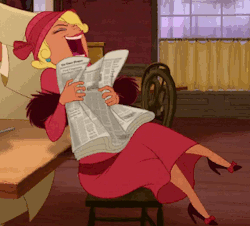
What is with the Dreamer's Houses? Herrah's Den
Okay, we can all agree that Team Cherry put a LOT of thought into crafting the backgrounds and environments of Hollow Knight. But why is nobody talking about the designs for the Dreamers' houses?! Especially compared with their base forms? Well, let's start talking about it!
Herrah
This is Herrah's design:

Herrah is massive compared to several creatures we have come across in Hallownest. While her mask and horns give off sharp and spooky vibes, take a look at her bottom half. It is round and supported by many limbs.
In comparison, Hornet is far slimmer than her mother, which can either come from her father's genes, her age, or lack of nutrition. Herrah, however, is matured in both mind and body. Herrah's body is like a woman's body which has gone through a pregnancy: stretched and curvy. I do not mean it in a demeaning way. No, these are Herrah's battle scars that she wears proudly as Hornet's mother.
Do people think about that when they see Herrah? No.
At first, they are put off by Herrah's sharp horns and six eyes. It is a mental aspect of our brains to associate sharpness with threats. But the roundness in character design is often associated with warmth and approachability. This Beast is the same person who Hornet called "Mama"; the deadly hunter queen who cuddled her baby.
By the time we meet Herrah within the Dream Realm to strike her, we should already know that she is Hornet's mother and be conflicted about killing her. Herrah's design only adds to the drama as we listen to Herrah's last words "For her…for her…"
Herrah is a Seal but also a Mom and a Queen. And most likely the main reason why anyone writes AUs sparing the Dreamers.
But I have written too much about Herrah. Let us check out her den!

The entrance is carefully spun while the door is framed by metal design not seen in Hallownest, implying that the Weavers know both the arts of metalwork and weaving.

After entering the Beast's Den, you are treated to a large hall. It seemed to have served as a dining hall, meeting hall, and war room in the past. Now, it is solely used to "prank" any visitors.
Both pictures, however, are the only ones that visitors see when they come to the Beast's Den. Unless you count the distorted view you get as you try to peer through the silk before you get eaten. Now, if you are lucky enough to be seen as a visitor and not future food, you will see the Weavers are crafty and capable in many arts: weaving, metalwork, and war.
Now, apply that to Herrah and you should carefully take a few steps away.
This, however, is what is applied to Herrah based on a public area. It is time to enter the Beast's Den proper.
And immediately you start to have claustrophobia. Webs everywhere…

Need I say more?

There is light, but it is very soft and in-between. Your lantern must suffice. But for the Weavers and Herrah, the light from the few lamps is more than enough.
Herrah's Den does not seem to be just for her glory alone, however, as several masks are seen.


IMPORTANT! Neither mask belongs to Herrah! The first mask is too round, like one the few Weavers we find alive in Deepnest, while the other is a Stalking Devout as seen by the hole where the mouth would go.
As for their significance, we are unfortunately left without a guide to tell us anything. But if they were in Herrah's Den with such fine art surrounding them, then Herrah wanted these masks there to honor whoever the masks represent. This detail speaks volumes of how Herrah greatly respects those whom she believes are worthy of honor, even if you must to travel into her den to know of her respect.
As for respect, let us see how the Weavers paid their last respects to Herrah as she laid dreaming to protect them all.

First, the room is the most lit in the whole den due to wide array of candles. Second, the webs are everywhere, but the angles framing the space make it far nicer on the eye (unlike the rest of the den. 😬). Herrah herself is laid perfectly centered, framed by two banners hanging. Even her hands are neatly folded in rest. This is no longer Herrah's home; it is her shrine.
Yet it seems that the Weavers are the ones who highlighted the importance of Herrah. The queen, after all, cared more about her people and daughter than herself. Of all the banners hung, the only markings on them are the six eyes of the Weavers, not just Herrah. It is her people's flag, not Herrah's.
One last thing to mention before moving on to the other Dreamers, is asking Herrah what in goodness gracious is this?!

As it is deep within Herrah's den and there are more pressing questions in Hollow Knight, I have not seen many attempts to answer it. As such, we have literally no idea except for some insight provided by the Fandom wiki. I quote:
Beast’s Den Shrine

"A room located in the west part of the Beast’s Den contains an unknown being. The file names for the sprites in this room refer to the area as a ‘shrine’. Hitting the being with the Nail produces a metallic sound. Hitting it with Spells makes a seal appear over it. It is unclear if this being is the corpse of an ancient bug or a statue.” Taken from the Hollow Knight wiki: Ancient Civilisation - Hollow Knight Wiki.
If this is true, then we found what Herrah worshiped, or at least what she let her people worship within her den. Whatever this thing, it is not Weaver in origin. The seal used on it does NOT match up with the various Weaver seals of protection we see in the rest of the game. Perhaps the Weavers learn how to make such seals and spells by studying this creature? If so, then it shows how Herrah is willing to learn from others to protect her people.
Willing to learn from anyone but Hallownest.


The bench and elevator are destroyed, specifically the ones from Hallownest as seen in their designs. It is not that Herrah does not like benches, but that she doesn't like Hallownest. See proof below.

The Bench design here fits far better with the Weaver metalwork than the broken bench in the Stag Station.
Herrah will use Hallownest to benefit her people, but it will always be on her terms.
Even the existence of the Stag Station is to further trade to increase power and influence for the Weavers while lowering the risk to them. Pro-Hallownestian or Pro-Weaver, you must admit that Herrah acts like a queen should, forever serving her people.
And that is all I could find! If you have any thoughts or questions, comment or reblog down below!
This is a part series to see if I can fit everything in. I hope you enjoyed Herrah's den!
Part 2.0: Monomon's Archives: Here
Part 3.0: Lurien's Spire : Here
Part 3.25: More of Lurien's Spire: Here
Part 3.5: Lurien's Spire: Pillows and Patriotism: Here
Part 3.7 Lurien's Spire: What is wrong with Lurien's Office?! Here
Part 3.8: Even, even More of Lurien's Spire: Secret Room: Click here
Part 3.9 Watcher Knight Boss Room! Here
Part 4.0 What We Know We Don't Know About the Dreamers' Houses: Click Here
Link to essay on Ao3: Here
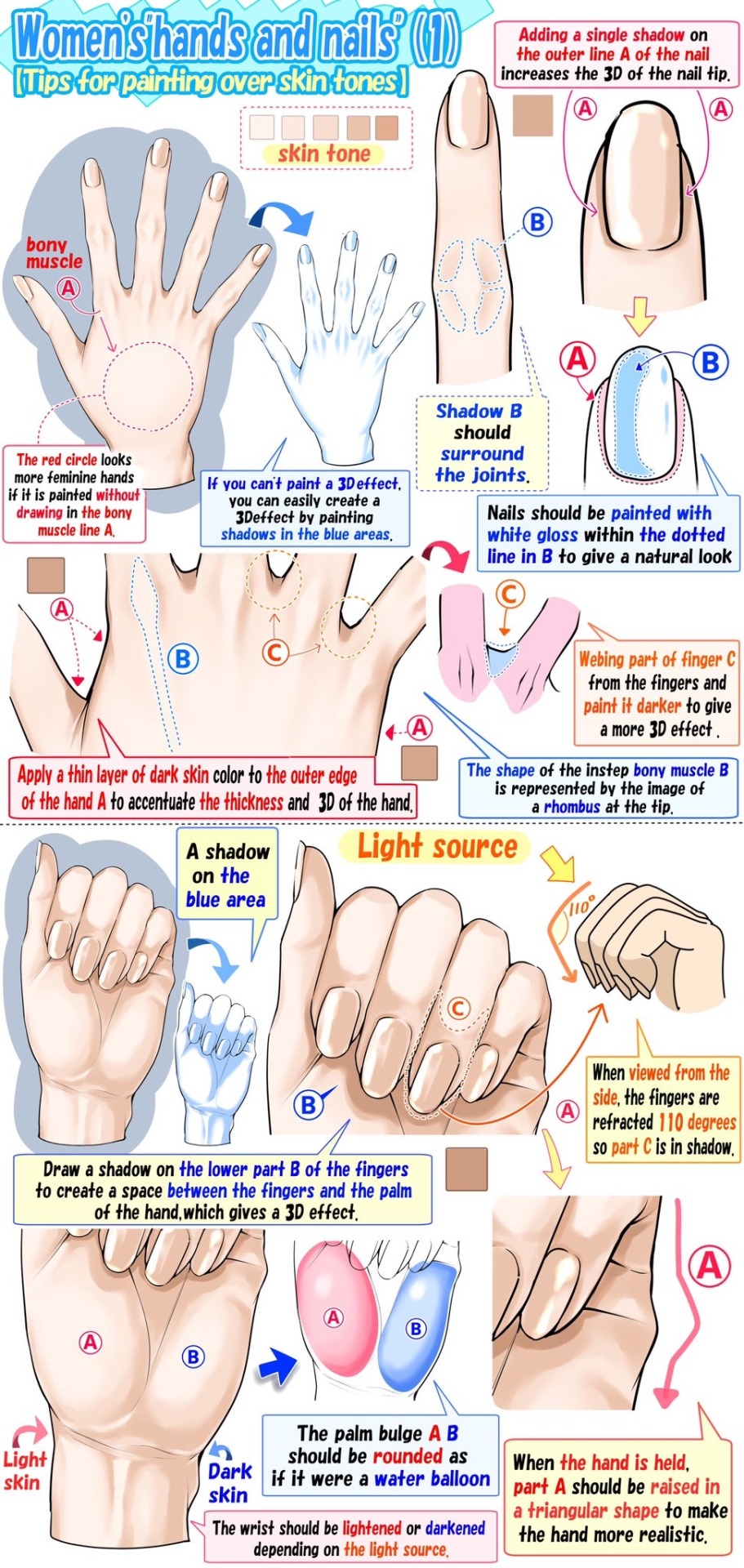
“Techniques for drawing beautifully silhouetted hands and nails”
Source: takuya_kakikata
-
 irritable-dumpliing liked this · 1 month ago
irritable-dumpliing liked this · 1 month ago -
 midnight-aura-star reblogged this · 1 month ago
midnight-aura-star reblogged this · 1 month ago -
 lychee-art reblogged this · 1 month ago
lychee-art reblogged this · 1 month ago -
 hundred-thousand-nightmares liked this · 1 month ago
hundred-thousand-nightmares liked this · 1 month ago -
 farshootingstar liked this · 1 month ago
farshootingstar liked this · 1 month ago -
 natethe101 liked this · 1 month ago
natethe101 liked this · 1 month ago -
 itiskriz liked this · 1 month ago
itiskriz liked this · 1 month ago -
 teethingpains liked this · 1 month ago
teethingpains liked this · 1 month ago -
 greenbeanpaste liked this · 1 month ago
greenbeanpaste liked this · 1 month ago -
 thresposts liked this · 1 month ago
thresposts liked this · 1 month ago -
 ledahrozwelli reblogged this · 1 month ago
ledahrozwelli reblogged this · 1 month ago -
 joyfuljoyce reblogged this · 1 month ago
joyfuljoyce reblogged this · 1 month ago -
 joyfuljoyce liked this · 1 month ago
joyfuljoyce liked this · 1 month ago -
 diceroulette reblogged this · 1 month ago
diceroulette reblogged this · 1 month ago -
 diceroulette liked this · 1 month ago
diceroulette liked this · 1 month ago -
 apollotg liked this · 1 month ago
apollotg liked this · 1 month ago -
 fiovske liked this · 1 month ago
fiovske liked this · 1 month ago -
 kaondecay reblogged this · 1 month ago
kaondecay reblogged this · 1 month ago -
 shrimplie liked this · 1 month ago
shrimplie liked this · 1 month ago -
 kayayayayayayay liked this · 1 month ago
kayayayayayayay liked this · 1 month ago -
 spectator-lawful-evil reblogged this · 1 month ago
spectator-lawful-evil reblogged this · 1 month ago -
 anikoo765 liked this · 1 month ago
anikoo765 liked this · 1 month ago -
 idontliketomatoesleavemealone liked this · 1 month ago
idontliketomatoesleavemealone liked this · 1 month ago -
 shouldwemaybe reblogged this · 1 month ago
shouldwemaybe reblogged this · 1 month ago -
 shouldwemaybe liked this · 1 month ago
shouldwemaybe liked this · 1 month ago -
 magic-is-beauty reblogged this · 1 month ago
magic-is-beauty reblogged this · 1 month ago -
 idontliketomatoesleavemealone reblogged this · 1 month ago
idontliketomatoesleavemealone reblogged this · 1 month ago -
 chaosdarialookalike liked this · 1 month ago
chaosdarialookalike liked this · 1 month ago -
 n30nd3m0n5 liked this · 1 month ago
n30nd3m0n5 liked this · 1 month ago -
 jasondelons liked this · 1 month ago
jasondelons liked this · 1 month ago -
 kaikkivoipasaatana liked this · 1 month ago
kaikkivoipasaatana liked this · 1 month ago -
 yukitsen liked this · 1 month ago
yukitsen liked this · 1 month ago -
 grrrasya liked this · 1 month ago
grrrasya liked this · 1 month ago -
 namelessanon liked this · 1 month ago
namelessanon liked this · 1 month ago -
 food-lover9000 reblogged this · 1 month ago
food-lover9000 reblogged this · 1 month ago -
 food-lover9000 liked this · 1 month ago
food-lover9000 liked this · 1 month ago -
 bitch-what-in-the-ass reblogged this · 1 month ago
bitch-what-in-the-ass reblogged this · 1 month ago -
 awwwasyuta liked this · 1 month ago
awwwasyuta liked this · 1 month ago -
 jelle-0 liked this · 1 month ago
jelle-0 liked this · 1 month ago -
 cherrybellchronicles reblogged this · 1 month ago
cherrybellchronicles reblogged this · 1 month ago -
 helloramona reblogged this · 1 month ago
helloramona reblogged this · 1 month ago -
 helloramona liked this · 1 month ago
helloramona liked this · 1 month ago -
 sirsnailmail liked this · 1 month ago
sirsnailmail liked this · 1 month ago -
 starlight-and-thunder liked this · 2 months ago
starlight-and-thunder liked this · 2 months ago -
 snuggledupblanketdragon reblogged this · 2 months ago
snuggledupblanketdragon reblogged this · 2 months ago -
 soaricarus reblogged this · 2 months ago
soaricarus reblogged this · 2 months ago -
 demeletron liked this · 2 months ago
demeletron liked this · 2 months ago
